Different Types of Speakers and Their Features!
Published: 1 Oct 2025
Guys, first, let’s clear up what a speaker is all about. A speaker is a device that makes sound so we can hear it. Think of it like a talking box that takes signals from things like phones or computers and turns them into sounds we hear.
In this article, we’ll explore different types of speakers, what makes each type unique, how they work, and where you might find them.
So, guys, without wasting any further time, let’s dive into the world of speaker types!
Types of Speakers
There are different kinds of speakers, each made to play sound differently and for a different reason. And knowing about them can help you pick the right one for your home, car, or big event.
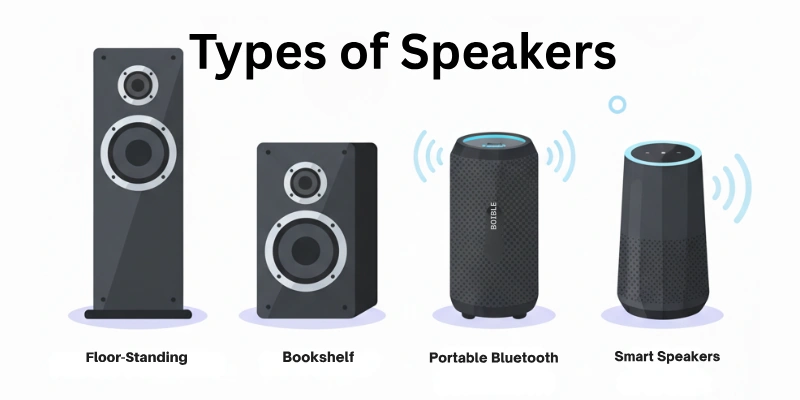
Here are the major speaker types mentioned:
- Bookshelf Speakers
- Floor-standing Speakers
- In-wall Speakers
- In-ceiling Speakers
- Soundbars
- Portable Bluetooth Speakers
- Wireless Speakers
- Smart Speakers
- Studio Monitors
- Subwoofers
- Center Channel Speakers
- Satellite Speakers
- Outdoor Speakers
- Powered Speakers
- Passive Speakers
- Electrostatic Speakers
- Planar Magnetic Speakers
- Horn Speakers
- Full-range Speakers
- Mid-range Speakers
- Tweeters
- Woofers
- Super Tweeters
- Ribbon Tweeters
- Coaxial Speakers
- Bi-polar Speakers
- Di-polar Speakers
- Omni-directional Speakers
- Line Array Speakers
- Column Speakers
- Underwater Speakers
Let’s learn about each in detail.
1. Bookshelf Speakers
Bookshelf speakers are small speakers designed to fit on shelves or small spaces. They are used for listening to music or watching movies.
Design and Technology
- Bookshelf speakers usually have a box shape. They contain drivers (small speakers inside) for high and low sounds. They might have one or two drivers.
Sound Quality
- Bookshelf speakers provide good sound for their size. They are not as powerful as larger speakers.
Applications and Usage
- Bookshelf speakers are used in small rooms, living rooms, or offices. They are good for home entertainment systems.
Pros
- Compact size
- Good sound
- Easy setup
Cons
- Limited bass
- Not very loud
2. Floor-standing Speakers
Floor-standing speakers are tall, free-standing speakers placed directly on the floor. They are used for high-quality sound in home audio systems.
Design and Technology
- Floor-standing speakers have a tall, box-like shape. They contain multiple drivers for different sound ranges: woofers for bass, mid-range drivers, and tweeters for high frequencies.
Sound Quality
- Floor-standing speakers provide excellent sound quality with deep bass and clear highs. They are powerful and can fill large rooms with sound.
Applications and Usage
- Floor-standing speakers are used in living rooms, home theaters, and larger spaces. They are ideal for serious music listeners and movie enthusiasts.
Pros
- Powerful sound
- Deep bass
- High clarity
Cons
- Large size
- Heavy
3. In-wall Speakers
In-wall speakers are speakers installed directly into the walls. They are used for a clean, space-saving sound system.
Design and Technology
- In-wall speakers are flat and fit flush with the wall surface. They have drivers and a grille that blends with the wall.
Sound Quality
- In-wall speakers provide good sound quality without taking up space. The sound is clear but might lack deep bass.
Applications and Usage
- In-wall speakers are used in living rooms, home theaters, and offices. They are great for hidden sound systems.
Pros
- Space-saving
- Clean look
- Good sound
Cons
- Installation needed
- Limited bass
4. In-ceiling Speakers
In-ceiling speakers are speakers installed into the ceiling. They are used to provide audio without taking up floor or wall space.
Design and Technology
- In-ceiling speakers are round or square-shaped and mount flush with the ceiling surface. They include drivers and a grille that blends with the ceiling.
Sound Quality
- In-ceiling speakers offer good sound quality and distribute audio evenly throughout a room. However, they may not produce deep bass compared to floor-standing speakers.
Applications and Usage
- In-ceiling speakers are commonly used in home audio systems, restaurants, offices, and other spaces where a discreet audio solution is needed.
Pros
- Easy installation
- Even sound distribution
- Saves space
Cons
- Installation required
- Limited bass
5. Soundbars
Soundbars are long, slim speakers that sit under or in front of a TV. They enhance TV audio quality.
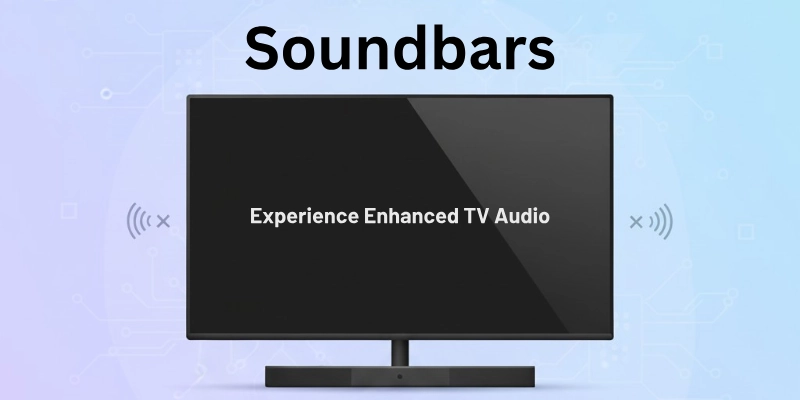
Design and Technology
- Soundbars are rectangular and contain multiple speakers inside. They often include subwoofers for better bass.
Sound Quality
- Soundbars improve TV sound significantly, offering clearer dialogue and better overall audio quality compared to built-in TV speakers.
Applications and Usage
- Soundbars are used with TVs in living rooms, bedrooms, and home theaters. They are popular for enhancing movie and music playback.
Pros
- Compact design
- Improved TV sound
- Easy setup
Cons
- Limited surround sound
- Sound quality varies
6. Portable Bluetooth Speakers
Portable Bluetooth speakers are small, wireless speakers that connect to devices like smartphones and tablets via Bluetooth. They are used for listening to music on the go.
Design and Technology
- Portable Bluetooth speakers come in various shapes and sizes, often compact and lightweight. They have built-in batteries for portability and usually include drivers and passive radiators for better sound.
Sound Quality
- Portable Bluetooth speakers offer decent sound quality for their size, suitable for casual listening outdoors or in small spaces. However, they may not match the audio fidelity of larger, stationary speakers.
Applications and Usage
- Portable Bluetooth speakers are used outdoors, at picnics, beaches, and indoor settings like bedrooms or kitchens. They provide convenient music playback without needing wires.
Pros
- Wireless and portable
- Easy connectivity
- Suitable for outdoor use
Cons
- Limited bass response
- Lower maximum volume
7. Wireless Speakers
Wireless speakers are speakers that connect to audio sources without using cables. They use technologies like Bluetooth or Wi-Fi for connectivity.
Design and Technology
Wireless speakers come in various shapes and sizes, from compact to large units. They include internal batteries for portability and drivers for sound production.
Sound Quality
- Wireless speakers generally provide good sound quality, comparable to wired speakers. However, the sound quality can vary based on the speaker’s size and design.
Applications and Usage
- Wireless speakers are used indoors and outdoors, in homes, offices, and outdoor gatherings. They offer flexibility in placement and are convenient for multi-room audio setups.
Pros
- No wires needed
- Easy setup and placement
- Versatile usage
Cons
- Battery life may vary
- Potential for connectivity issues
8. Smart Speakers
Smart speakers are wireless speakers with built-in voice assistants like Amazon Alexa or Google Assistant. They are used for voice commands and smart home control.
Design and Technology
- Smart speakers vary in size and design, typically compact and modern-looking. They include microphones, speakers, and connectivity features for internet access.
Sound Quality
- Smart speakers offer decent sound quality suitable for casual listening and voice responses. However, they may not match the audio accuracy of dedicated audio systems.
Applications and Usage
- Smart speakers are used in homes and offices for voice commands, music streaming, controlling smart devices, and accessing information like weather or news.
Pros
- Voice control functionality
- Smart home integration
- Convenient information access
Cons
- Sound quality varies by model
- Privacy concerns with voice data
9. Studio Monitors
Studio monitors are specialized speakers used by audio professionals for recording, mixing, and mastering audio in studios.
Design and Technology
- Studio monitors are designed for accurate sound reproduction. They come in various sizes and typically have a neutral sound profile to reveal audio flaws.
Sound Quality
- Studio monitors provide high-quality, accurate sound reproduction, essential for precise audio editing and production tasks.
Applications and Usage
- Studio monitors are used in recording studios, broadcast facilities, and home studios by musicians, producers, and audio engineers.
Pros
- Accurate sound reproduction
- Ideal for audio professionals
- Detailed sound quality
Cons
- May require acoustically treated rooms
- Less bass emphasis
10. Subwoofers
Subwoofers are speakers designed to reproduce low-frequency sound, especially bass tones, in audio systems.
Design and Technology
- Subwoofers are typically large and box-shaped with specialized drivers called woofers. They focus on producing deep, powerful bass sounds.
Sound Quality
- Subwoofers excel at reproducing deep bass frequencies, enhancing the overall audio experience by filling out the lower end of the sound spectrum.
Applications and Usage
- Subwoofers are used in home theaters, car audio systems, and professional audio setups to add depth and impact to music and movie soundtracks.
Pros
- Enhances bass performance
- Adds depth to audio
- Improves overall sound quality
Cons
- Requires additional space
- Can overpower other frequencies if not balanced
11. Center Channel Speakers
Center channel speakers are special speakers used in home theaters.
Design and Technology
- Center channel speakers are flat and made to play voices and sounds in the middle of movies and TV shows. They have many parts inside to make voices clear.
Sound Quality
- Center channel speakers make voices clear and easy to understand in movies and shows. They focus on middle sounds.
Applications and Usage
Center channel speakers are used in home theaters with TVs.
Pros
- Makes voices clear
- Helps with movie sound
Cons
- Mostly used for home theaters
12. Satellite Speakers
Satellite speakers are small speakers used in home audio systems.
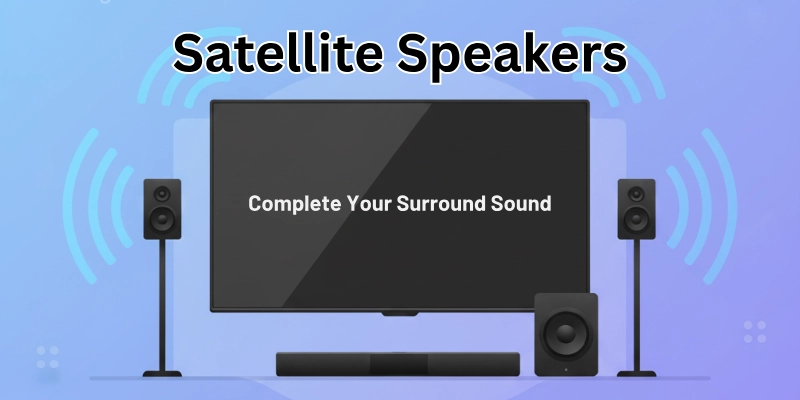
Design and Technology
- Satellite speakers are compact and designed to produce high and mid-range sounds. They can be mounted on walls or placed on stands.
Sound Quality
- Satellite speakers provide clear sound for their size, focusing on high and mid-range frequencies.
Applications and Usage
- Satellite speakers are used in surround sound systems and as rear speakers in home theater setups. They help create a more immersive audio experience.
Pros
- Compact size
- Clear sound
- Versatile placement options
Cons
- Limited bass
- Might need additional subwoofer
13. Outdoor Speakers
Outdoor speakers are speakers designed for use outside, such as in gardens or on patios.
Design and Technology
- Outdoor speakers are built to withstand weather conditions like rain and sun. They are often rugged and sealed to protect against moisture.
Sound Quality
- Outdoor speakers provide decent sound quality suitable for outdoor listening environments. They focus on clear sound projection.
Applications and Usage
- Outdoor speakers are used in gardens, patios, pool areas, and outdoor events to provide background music or entertainment.
Pros
- Weather-resistant
- Durable construction
- Suitable for outdoor environments
Cons
- Sound quality may vary with environment
- Installation might require outdoor wiring
14. Powered Speakers
Powered speakers are speakers that have built-in amplifiers, meaning they do not require an external amplifier to produce sound.
Design and Technology
- Powered speakers include amplifiers inside their cabinets, allowing them to directly connect to audio sources like computers, TVs, or turntables.
Sound Quality
- Powered speakers offer good sound quality with clear and balanced audio reproduction. They are designed to deliver consistent sound without distortion.
Applications and Usage
- Powered speakers are used for home audio systems, desktop setups, studios, and small events where a compact and self-contained sound solution is needed.
Pros
- Built-in amplification
- Easy setup
Cons
- May be heavier due to built-in amplifiers
15. Passive Speakers
Passive speakers are speakers that require an external amplifier to produce sound.
Design and Technology
- Passive speakers do not have built-in amplifiers. They rely on external amplifiers to receive power and drive the audio signals.
Sound Quality
- Passive speakers can provide excellent sound quality, depending on the quality of the amplifier used with them. They allow for more customization and flexibility in sound setup.
Applications and Usage
- Passive speakers are commonly used in home audio systems, concert venues, and professional audio setups.
Pros
- Can be paired with different amplifiers
- High potential for sound quality customization
- Suitable for various audio setups
Cons
- Require separate amplifier purchase
- More complex setup compared to powered speakers
16. Electrostatic Speakers
Electrostatic speakers are specialized audio speakers that use an electrostatic panel to produce sound.
Design and Technology
- Electrostatic speakers have a thin, flat panel that vibrates to create sound. They use an electric charge to move the panel back and forth, producing sound waves.
Sound Quality
- Electrostatic speakers are known for their high-quality sound reproduction, offering clear and detailed audio across a wide range of frequencies.
Applications and Usage
Electrostatic speakers are used in high-end audio systems, home theaters, and professional audio environments.
Pros
- High-fidelity sound
- Clear and detailed audio
- Unique design and technology
Cons
- Expensive
- Require careful handling and maintenance
17. Planar Magnetic Speakers
Planar magnetic speakers are advanced audio speakers that use a thin film and magnets to create sound.
Design and Technology
- Planar magnetic speakers have a thin film diaphragm with a conductive trace suspended between magnets. When the electrical signal passes through the trace, it moves the diaphragm to produce sound.
Sound Quality
- Planar magnetic speakers are known for their high-resolution sound and accurate audio reproduction, especially in the mid-range and high frequencies.
Applications and Usage
- Planar magnetic speakers are used in high-fidelity audio systems, home theaters, and professional studios.
Pros
- High-resolution audio
- Accurate sound reproduction
- Low distortion
Cons
- Can be expensive
- Larger and heavier than some other speaker types
18. Horn Speakers
Horn speakers are speakers that use a horn-shaped structure to amplify sound.
Design and Technology
- Horn speakers have a driver that sends sound through a horn, which increases the efficiency and direction of the sound waves.
Sound Quality
- Horn speakers are known for their loud and clear sound, with high efficiency and minimal distortion.
Applications and Usage
Horn speakers are used in public address systems, theaters, concert venues, and places where loud and clear sound is needed over long distances.
Pros
- Loud sound
- High efficiency
- Clear audio
Cons
- Can be large
19. Full-range Speakers
Full-range speakers are speakers designed to reproduce a wide range of audio frequencies from low bass to high sound.
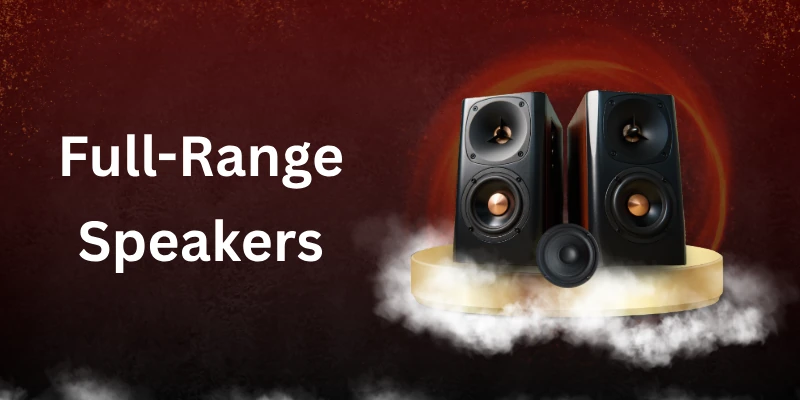
Design and Technology
- Full-range speakers typically have a single driver that covers the entire frequency spectrum, eliminating the need for multiple drivers or crossover networks.
Sound Quality
- Full-range speakers offer balanced sound quality but may lack the deep bass.
Applications and Usage
- Full-range speakers are used in simple audio setups, portable sound systems, and as part of larger speaker systems to cover the full audio range.
Pros
- Simple design
- Balanced sound
- No need for crossovers
Cons
- Limited bass
- May not handle high volume well
20. Mid-range Speakers
Mid-range speakers typically have a cone-shaped driver optimized for handling the middle part of the audio spectrum, usually between 300 Hz and 5,000 Hz.
Sound Quality
- Mid-range speakers provide clear and detailed sound for vocals and instruments, ensuring that the most important parts of the music are accurately reproduced.
Applications and Usage
- Mid-range speakers are used in home audio systems, car audio systems, and professional sound setups.
Pros
- Clear vocals
- Detailed mid-range sound
- Enhances overall audio clarity
Cons
- Limited bass
- Limited high frequencies
21. Tweeters
Tweeters are small speakers designed to reproduce high-frequency sounds.
Design and Technology
- Tweeters have a small driver, often made of materials like silk, metal, or ceramic, that vibrates quickly to produce high-pitched sounds, typically from 2,000 Hz to 20,000 Hz.
Sound Quality
- Tweeters provide clear and crisp high-frequency sounds, essential for detailed audio reproduction like cymbals, vocals, and other high-pitched instruments.
Applications and Usage
- Tweeters are used in home audio systems, car audio systems, and professional sound systems to enhance the clarity and detail of high-frequency sounds.
Pros
- Clear high frequencies
- Adds detail to audio
- Essential for balanced sound
Cons
- Limited to high frequencies
- Requires other speakers for full range sound
22. Woofers
Woofers are speakers designed to reproduce low-frequency sounds, commonly known as bass.
Design and Technology
- Woofers have a larger driver and a sturdy cone, usually made of materials like paper, plastic, or metal, which moves back and forth to produce low-pitched sounds, typically from 20 Hz to 2,000 Hz.
Sound Quality
- Woofers provide deep and powerful bass, adding richness and depth to music and sound effects.
Applications and Usage
- Woofers are used in home audio systems, car audio systems, and professional sound setups to enhance the low-frequency sounds, such as bass lines and drum beats.
Pros
- Deep bass
- Adds richness to sound
- Enhances low-frequency effects
Cons
- Limited to low frequencies
- Needs other speakers for full range sound
23. Super Tweeters
Super tweeters are specialized speakers designed to reproduce very high-frequency sounds beyond the range of standard tweeters.
Design and Technology
- Super tweeters have small drivers made of advanced materials like metal or ceramic. They vibrate at extremely high frequencies, typically above 20,000 Hz, to produce ultra-high-pitched sounds.
Sound Quality
- Super tweeters provide ultra-clear and detailed high-frequency sounds, adding a sense of space and airiness to the audio.
Applications and Usage
Super tweeters are used in high-end audio systems, home theaters, and professional audio setups.
Pros
- Ultra-clear highs
- Enhances audio detail
- Adds spaciousness to sound
Cons
- Limited to very high frequencies
- Expensive
24. Ribbon Tweeters
Ribbon tweeters are high-frequency speakers that use a thin metal ribbon to produce sound.
Design and Technology
- Ribbon tweeters have a thin, flat ribbon of metal that vibrates to produce high-frequency sounds. This ribbon moves in a magnetic field, creating clear and detailed audio.
Sound Quality
- Ribbon tweeters offer clear and detailed high-frequency sound with minimal distortion.
Applications and Usage
- Ribbon tweeters are used in high-end audio systems and studio monitors for precise high-frequency reproduction.
Pros
- Clear highs
- Low distortion
- Precise sound
Cons
- Expensive
25. Coaxial Speakers
Coaxial speakers are speakers that have multiple drivers set up on the same axis.
Design and Technology
- Coaxial speakers typically have a woofer and a tweeter combined in one unit, with the tweeter mounted in the center of the woofer cone.
Sound Quality
- Coaxial speakers provide balanced sound from a single point source, making them great for compact audio setups.
Applications and Usage
- Coaxial speakers are commonly used in car audio systems, home audio setups, and portable speaker systems.
Pros
- Balanced sound
- Space-saving design
- Easy installation
Cons
- Limited sound separation
- Mid-range performance varies
26. Bi-polar Speakers
Bi-polar speakers are speakers that radiate sound from both the front and the back.
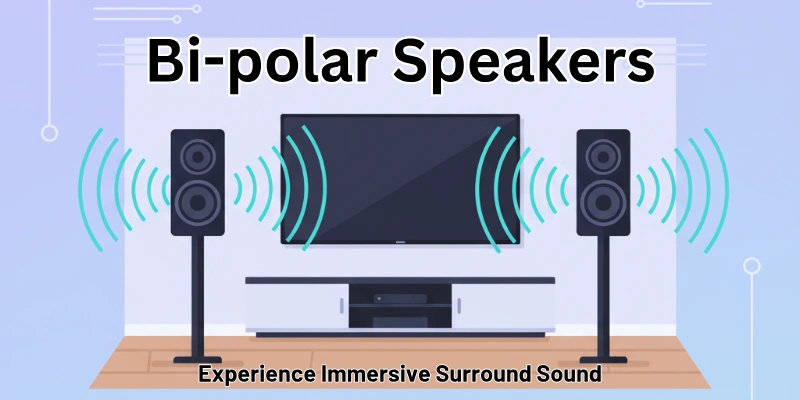
Design and Technology
- Bi-polar speakers have drivers on both the front and back panels, creating a more immersive sound field by reflecting sound off walls.
Sound Quality
- The sound produced by bi-polar speakers is expansive and engaging.
Applications and Usage
- Bi-polar speakers are used in home theaters and surround sound systems to enhance the audio experience.
Pros
- Immersive sound
- Wide sound field
- Great for surround sound
Cons
- Placement sensitive
- Can be expensive
27. Di-polar Speakers
Di-polar speakers are speakers that emit sound from both sides, but out of phase with each other.
Design and Technology
- Di-polar speakers have drivers on both the front and back, but they operate out of phase, meaning when one side’s driver pushes out, the other pulls in, creating a diffuse sound.
Sound Quality
- Di-polar speakers produce a normal sound that makes it more difficult to identify the source of the sound.
Applications and Usage
- Di-polar speakers are used in surround sound systems, particularly for side or rear channels in home theaters.
Pros
- Natural sound
- Enhances surround effect
Cons
- Placement critical
- Can lack directness
28. Omni-directional Speakers
Omni-directional speakers are speakers that radiate sound evenly in all directions.
Design and Technology
- Omni-directional speakers have drivers arranged to emit sound in a 360-degree pattern, ensuring even sound distribution throughout a space.
Sound Quality
- Omni-directional speakers provide uniform sound coverage, creating a natural and immersive listening experience.
Applications and Usage
- Omni-directional speakers are used in open areas, large rooms, and outdoor spaces where even sound distribution is desired.
Pros
- Uniform sound distribution
- Immersive audio
- Ideal for large spaces
Cons
- Can be less focused
- May need careful placement
29. Line Array Speakers
Line array speakers are speaker systems designed to project sound over long distances with minimal loss of volume and clarity.
Design and Technology
- Line array speakers are made up of several speaker units placed vertically to efficiently combine and spread sound waves across great distances.
Sound Quality
- Line array speakers deliver clear and consistent sound across large areas.
Applications and Usage
- Line array speakers are used in concert halls, stadiums, and large outdoor events to ensure even sound coverage for large audiences.
Pros
- Long-distance sound projection
- Clear and consistent audio
- Ideal for large venues
Cons
- Large and bulky
- Expensive
30. Column Speakers
Column speakers are tall, slim speakers designed to provide clear sound with a focus on vocal clarity and mid-range frequencies.
Design and Technology
- Column speakers have multiple small drivers arranged vertically in a tall, narrow enclosure, which helps in sound dispersion and reducing feedback.
Sound Quality
- Column speakers offer clear and focused sound, particularly in the mid-range, making them great for speech and vocal performances.
Applications and Usage
- Column speakers are used in public address systems, houses of worship, and conference rooms where vocal clarity is important.
Pros
- Clear mid-range
- Focused sound
- Reduces feedback
Cons
- Limited bass
- Not ideal for high-volume music
31. Underwater Speakers
Underwater speakers are specialized speakers designed to work underwater, providing audio for swimmers and underwater activities.
Design and Technology
- Underwater speakers are waterproof and built to withstand pressure and moisture.
Sound Quality
- Underwater speakers provide good sound quality underwater, ensuring that audio can be heard clearly even while swimming.
Applications and Usage
- Underwater speakers are used in pools, aquariums, and underwater training facilities to provide music, instructions, or ambient sounds.
Pros
- Waterproof
- Clear underwater audio
- Durable
Cons
- Limited to underwater use
- Can be expensive
Conclusion
So guys, in this article we have covered all the types of speakers in detail.
When choosing a speaker brand, consider well-known brands like Bose, JBL, and Sony for reliable quality. These brands offer a range of speakers that fit different needs and budgets. For professional audio, brands like Yamaha and KRK are great options.
When setting up your speakers, make sure to place them correctly for the best sound. For example, keep floor-standing speakers away from walls and corners to avoid sound distortion. Also, clean your speakers regularly to keep them in good condition.
If you have any questions or need more help, feel free to ask in the comment section. We’re here to help!
FAQs’
Here are some most commonly asked questions related to the different types of speakers.
Computer speakers are speakers designed to be used with computers. They connect to the computer to play sound from videos, music, games, and other media.
Powered speakers have built-in amplifiers, so they don’t need an external amp. Passive speakers need an external amplifier to work.
Yes, bookshelf speakers are good for home theaters if paired with a subwoofer for better bass. They are compact and fit well in smaller spaces.
Yes, you can use outdoor speakers indoors, but they are specifically designed to withstand weather conditions, so indoor speakers might provide better sound quality.
Bookshelf speakers or satellite speakers are great for small rooms because they are compact and provide good sound without taking up much space.
Not necessarily. Floor-standing speakers often have good bass, but adding a subwoofer can enhance deep bass for a richer sound experience.
Smart speakers can connect to the internet, allowing you to stream music, control smart home devices, and use voice commands for convenience.
Wireless speakers offer convenience and flexibility in placement. While they can provide good sound quality, wired speakers often offer more reliable and higher-quality sound.

- Be Respectful
- Stay Relevant
- Stay Positive
- True Feedback
- Encourage Discussion
- Avoid Spamming
- No Fake News
- Don't Copy-Paste
- No Personal Attacks

- Be Respectful
- Stay Relevant
- Stay Positive
- True Feedback
- Encourage Discussion
- Avoid Spamming
- No Fake News
- Don't Copy-Paste
- No Personal Attacks





